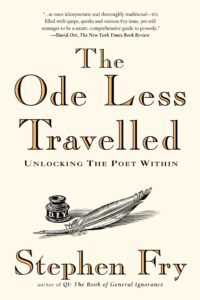Stephen Fry on Meter, Part 2
 As I mentioned previously, I’m working through Stephen Fry’s The Ode Less Travelled very slowly to absorb as much wisdom as I can about writing poetry. This week’s post covers Chapter 1, Section 2, on end-stopping, enjambment, caesura, weak endings, and trochaic and pyrrhic substitutions.
As I mentioned previously, I’m working through Stephen Fry’s The Ode Less Travelled very slowly to absorb as much wisdom as I can about writing poetry. This week’s post covers Chapter 1, Section 2, on end-stopping, enjambment, caesura, weak endings, and trochaic and pyrrhic substitutions.
This section of the chapter follows on learning the rules for iambic pentameter with learning how to break those rules. The list above includes many of those “rule breaking” options for writing iambic pentameter, complete with examples from Shakespeare’s sonnets and other poets who have written pieces that are called iambic pentameter even as they use these substitutions to make for a better line of poetry. A quote I noted in this section was “adherence to metre does not militate against naturalness,” which I found was a lovely way to summarize these techniques.
The exercises in this section included writing more iambic pentameter, getting practice first with end-stopping, enjambment, and caesura, and then with weak endings and trochaic and pyrrhic substitutions. The first exercise had topics for writing on, and then asked the reader to rework those lines to use enjambment and caesura–in all the cases where I did this exercise, the second versions of the lines were much more interesting. The second exercise was to write 16 lines of iambic pentameter and use the various new techniques learned. For me, this turned into four pieces of four lines each, most of which didn’t turn out great, but I was fond of this one:
The tulip’s petals vivid with the hues
of violet, pink, orange, and gleaming gold,
a harbinger of spring around the corner,
an ending to the weather trending cold.
It even rhymes!
Part of my brain rebels against the idea of these techniques, as they seem like “cheating.” But I guess if famous poets have used them, it’s okay for me to do so as well. It certainly makes what initially felt like a daunting form seem a bit easier than it did before I started on these exercises. I think that means I’m learning how to play with the form!

Comments